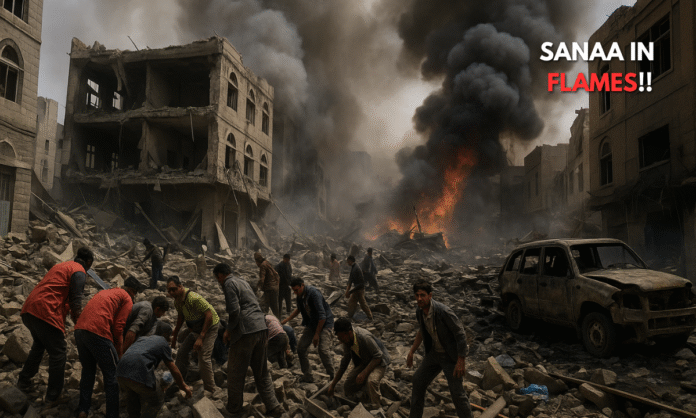SUMMARY
- Houthi rebels say 12 civilians killed, 30 wounded in US airstrike on Sanaa’s Farwa market.
- Strike follows deadly Ras Isa port bombing that killed 74, as US targets Houthi strongholds over Red Sea shipping attacks.
- US military’s Central Command has not confirmed the latest strikes; toll assessment remains murky due to limited access and information control.
Farwa Market Bombed as US Escalates Strikes on Houthis
Sanaa, Yemen | April 21, 2025 — In the latest escalation of the United States’ military campaign in Yemen, 12 people were killed and 30 injured in airstrikes on Sanaa’s Farwa neighborhood, according to statements released by the Iran-aligned Houthi rebels on Monday.
The airstrike, which hit a local market in the Shuub district, is part of what appears to be a rapidly intensifying series of strikes aimed at crippling the Houthis’ military and logistical infrastructure. The U.S. Central Command (CENTCOM) has not yet acknowledged the attack.
“The American enemy continues its aggression on the Yemeni people,” a Houthi military spokesperson said, accusing the US of targeting civilians to weaken morale.
US AIRSTRIKES: Killed 12 People in Yemen’s Capital, the Houthi Rebels Say pic.twitter.com/X8ZZrqJNPl
— SEGAMI (@segamihcfund) April 21, 2025
Follow-Up to Ras Isa: From Fuel Port to Capital Markets
The Farwa strike follows last week’s US attack on the Ras Isa fuel port, which killed at least 74 people and injured 171, making it one of the deadliest American operations in Yemen in years. The cumulative toll from the past week now exceeds 86 deaths and over 200 injuries, with airstrikes also reported in other provinces, including Hodeida and Saada.
The US has not provided a comprehensive breakdown of its strike targets or civilian casualties, citing operational secrecy. However, NGOs and aid workers operating on the ground say markets, fuel depots, and suspected command centers have all been affected.
Red Sea Tensions: Targeting Houthis Amid Shipping Disruption
- From Nov 2023 to Jan 2025, Houthis attacked 100+ merchant vessels in the Red Sea, sinking two and killing four sailors.
- US-led coalition operations aim to restore commercial traffic, which usually sees $1 trillion in trade annually.
- The Houthis claim they are acting in solidarity with Palestinians in Gaza, citing Israel’s aid blockade as justification for Red Sea disruptions.
The Houthis are the only Iran-backed group still actively engaging Israeli-linked ships, positioning them as the frontline force in Iran’s so-called “Axis of Resistance.”
Their repeated use of ballistic missiles, drones, and naval mines has made the Red Sea corridor unpredictable for international shipping. Insurance premiums on maritime cargo have skyrocketed, and several global shipping lines have rerouted vessels around the Cape of Good Hope, adding weeks to delivery timelines.
Political Backdrop: US-Iran Talks Resume in Rome
The airstrikes come against the backdrop of renewed US-Iran nuclear negotiations in Rome. Washington has linked Tehran’s support for the Houthis to its decision to intensify air operations in Yemen.
While President Trump’s administration has kept public focus on the economic impact of Red Sea disruptions, defense insiders suggest the military campaign against Houthis is now the most extensive since 2015, surpassing even the Biden-era containment strategy.
“This is a calibrated offensive,” said a senior U.S. defense analyst. “The goal is not just deterrence—it’s degradation of capabilities before more regional chaos unfolds.”
Civilian Toll, Access & Accountability
- Independent verification of casualties is nearly impossible due to restricted access to Houthi-controlled territories.
- The Houthis control all local press and do not release full lists of the deceased, while US military transparency remains limited.
- Humanitarian agencies are calling for a pause in strikes to allow medical evacuations and aid delivery.
Human rights observers warn that without full disclosure from CENTCOM, the true impact on civilian infrastructure and non-combatant lives will remain hidden.
Final Word: Fog of War, But the Fires Are Real
As the Red Sea conflict expands, Yemen is once again the arena for proxy warfare, regional defiance, and global military power projection. The Farwa market bombing is not just another tragedy—it’s a reflection of how civilian spaces continue to become battlegrounds in geopolitically entangled wars.
The question remains: how far will the escalation go before diplomacy—not just drones—takes center stage?


